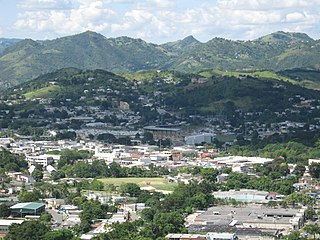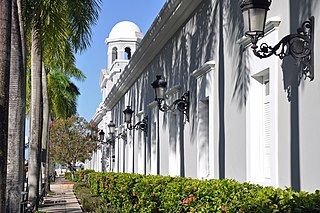
Cayey, officially Cayey de Muesas, is a mountain town and municipality in central Puerto Rico located on the Sierra de Cayey within the Central Mountain range, north of Salinas and Guayama; south of Cidra and Caguas; east of Aibonito and Salinas; and west of San Lorenzo. Cayey is spread over 21 barrios plus Cayey Pueblo. It is part of the San Juan-Caguas-Guaynabo Metropolitan Statistical Area.
Tourism in Puerto Rico attracts millions of visitors each year, with more than 5.1 million passengers arriving at the Luis Muñoz Marín International Airport in 2022, the main point of arrival into the island of Puerto Rico. With a $8.9 billion revenue in 2022, tourism has been a very important source of revenue for Puerto Rico for a number of decades given its favorable warm climate, beach destinations and its diversity of natural wonders, cultural and historical sites, festivals, concerts and sporting events. As Puerto Rico is an unincorporated territory of the United States, U.S. citizens do not need a passport to enter Puerto Rico, and the ease of travel attracts many tourists from the mainland U.S. each year.

Old San Juan is a historic district located at the "northwest triangle" of the islet of San Juan in San Juan. Its area roughly correlates to the Ballajá, Catedral, Marina, Mercado, San Cristóbal, and San Francisco sub-barrios (sub-districts) of barrio San Juan Antiguo in the municipality of San Juan, Puerto Rico. Old San Juan is the oldest settlement within Puerto Rico and the historic colonial district of the city of San Juan. This historic district is a National Historic Landmark District named Zona Histórica de San Juan and is listed on the United States National Register of Historic Places as the Old San Juan Historic District. Several historical buildings and structures, particularly La Fortaleza, the city walls, and El Morro and San Cristóbal castles, have been inscribed in the UNESCO World Heritage Site list since 1983. Historically the mixed-use commercial and residential real estate in the main streets of Calle Cristo and Calle Fortaleza from Calle Tanca to the Governor’s Mansion is the most valuable in the area and it has kept its value and increased steadily through several years despite the past economic turmoils.

The Baños de Coamo, located in the municipality of Coamo, are one of Puerto Rico's thermal springs.
Paradores in Puerto Rico is a brand of small inns similar to bed and breakfasts that have government permission to call themselves paradores based on a set of criteria. These inns are scattered across the island countryside, outside the main metropolitan area of San Juan. Often called "country inns" in English, paradores in Puerto Rico are known for their hospitality, affordable rates, exotic locations, and traditional Puerto Rican cuisine. They are frequented by guests looking to enjoy the local customs and charm.

Hacienda Juanita is a coffee plantation hacienda in the town of Maricao, Puerto Rico. The design is based on typical Puerto Rican culture, and was commissioned by the wife of a Spanish official. Coffee production at the hacienda declined from the 1960s.

The Puerto Rico Tourism Company is the government-owned corporation in charge of tourism matters and regulations in Puerto Rico. The company was created during Governor Luis A. Ferré's administration (1969-1973) to coordinate the marketing and growth of Puerto Rico's tourism sector. It is governed by a board of directors and an executive director appointed by the Governor of Puerto Rico with the advice and consent of the Senate of Puerto Rico.

Casa del Rey is a historic building and former cabildo located in the historic center of Dorado, Puerto Rico. Throughout its history it has also been known as the Militia Guard Headquarters, Parador del Rey, and the Municipal Jail of Dorado.

The Condado Vanderbilt Hotel is a historic luxury hotel built in 1919 and located on Ashford Avenue in the district of Condado in San Juan, capital city of the U.S. territory of Puerto Rico. It was listed on the National Register of Historic Places in 2008. The hotel was designed by the architectural firm Warren and Wetmore, who also designed New York's Grand Central Terminal. It was built by the Vanderbilt family and it marked the beginning of high end tourism in Puerto Rico.

Porta del Sol, or simply West Region, is a tourism region in western Puerto Rico. Porta del Sol was the first tourism region to be established by the Puerto Rico Tourism Company. It consists of 17 municipalities in the western area: Quebradillas, Isabela, San Sebastián, Moca, Aguadilla, Aguada, Rincón, Añasco, Mayagüez, Las Marías, Maricao, Hormigueros, San Germán, Sabana Grande, Guánica, Lajas and Cabo Rojo.

The Ponce Historic Zone is a historic district in downtown Ponce, Puerto Rico, consisting of buildings, plazas and structures with distinctive architectures such as Neoclásico Isabelino and the Ponce Creole, a local architectural style developed between the 19th- and early 20th-centuries. The zone goes by various names, including Traditional Ponce, Central Ponce, Historic Ponce, and Ponce Historic District.

Fiesta Inn is a Mexican business-class hotel brand. It is owned by Grupo Posadas, Inc., which also owns other Mexican hotel brands, including the upscale Fiesta Americana and Fiesta Americana Grand, ultra-luxury Live Aqua, One, and the eco-tourist Explorean. There are 61 hotels operated under this brand throughout the country.

Porta Cordillera, or simply Central Region, is a land-locked tourism region located in the central mountainous area of Puerto Rico. Porta Cordillera was officially launched in July 2012 by the Puerto Rico Tourism Company. It consists of 16 municipalities: Aguas Buenas, Cidra, Cayey, Comerío, Aibonito, Naranjito, Barranquitas, Corozal, Orocovis, Morovis, Ciales, Jayuya, Florida, Utuado, Adjuntas and Lares.

The Castle of the Bishops of Sigüenza is located in Sigüenza in the Province of Guadalajara in central Spain. With foundations dating back to the 5th century, it was extended by the Moors and retaken for the Christians by Bernard of Agen in 1123.

The Palace of the Counts of Maceda, or Casa del Barón in Pontevedra, Spain, is an original Renaissance pazo dating from the 16th century. It is currently a four-star hotel belonging to the Paradores network.

Paradores de Turismo de España S.M.E.S.A., branded as Paradores, is a Spanish state-owned chain of luxury hotels that are usually located in historic buildings or in nature areas with a special appeal. Its very first parador was inaugurated on 9 October 1928 in Navarredonda de Gredos (Ávila). As of 2023, it operates ninety-seven paradores in Spain and one in Portugal, with 5,986 rooms in total. Every parador has its own restaurant offering the regional gastronomy of its area.
José Luis Picardo Castellón was a Spanish architect, muralist, draughtsman and illustrator, usually known professionally without his matronymic as José Luis Picardo. As an architect he worked in contrasting architectural languages throughout his career, from the acclaimed modernist headquarters of the Fundación Juan March in Madrid to the neo-Renaissance style School of Equestrian Art in Jerez de la Frontera, by way of the many medieval-inspired hotel projects he carried out for the Paradores de Turismo de España. While still a student of architecture he made a name for himself as a muralist, embellishing many significant modern interiors in Spain. His drawing skills and his abilities in perspective brought him to the attention of a number of leading architects after the Spanish Civil War, and for some years he provided illustrations, cartoons and covers for two of the foremost Spanish architectural magazines. He also designed interiors, furniture and light fittings for many of his architectural projects. In later life he was elected an Academician of the Real Academia de Bellas Artes de San Fernando and was awarded the Antonio Camuñas Prize for Architecture.

The Parador de Almagro, also known as the Convento de Santa Catalina de Siena, is a four-star Parador hotel located in the town of Almagro, in the province of Ciudad Real, in the autonomous community of Castile-La Mancha, Spain. It was converted from the ruins of the seventeenth century Franciscan Convent of Santa Catalina. It was irretrievably damaged during the Spanish Civil War. In 1969 it was ceded to the Spanish government for conversion into a Parador. Work on the rebuilding and conversion began in 1972. The architects copied the architectural style of the original building, using materials sourced locally. For hotel use the historical layout of the convent was extended into the surrounding grounds with the construction of fifty-five guest rooms, numerous hospitality areas and fourteen patios.

The Parador de Úbeda, also known as the Palacio del Deán Ortega, the Palacio del Marqués del Donadío and the Parador del Condestable Dávalos is a four-star Parador hotel located in the oldest part of the city of Úbeda, in the province of Jaén, in the eastern part of the autonomous community of Andalucía, Spain. It is situated in the monumental Plaza de Vázquez de Molina, and surrounded by other imposing Renaissance buildings. It was converted into a hotel from one of the most important Renacimiento español palaces in the city.

The Parador de Oropesa, also known as Virrey de Toledo, is a four-star Parador hotel located in the town of Oropesa, in the province of Toledo, in the autonomous community of Castile-La Mancha, Spain. It was converted over a number of years from two of the buildings forming the compound of the Castillo de Oropesa. The Parador is located both in the Palacio Viejo, also known as the Palacio Doña Elvira, which dates from the end of the 14th century, and in the Palacio Nuevo (Oropesa), also known as the Palacio de los Álvarez de Toledo, which was built in the 16th century.

















